As students and administrators approach the final weeks of the fall semester, the district is considering plans of opening the school for hybrid learning some time in the second semester if coronavirus conditions improve in Santa Clara County.
The hybrid model would allow smaller groups of students to receive in-person instruction from teachers during normal school hours. Although nothing has been decided, one model includes in-person classes mixed with asynchronous activities for remote students who have already attended the in-person session for that week (in other words, groups alternate between live and remote instruction). In another model, in-person classes are live-streamed to half the students tuning in from remote. (This is the model that four classes are using at the school right now in Phase 2B.)
Plans to reopen the schools are currently on hold due to a surge in COVID-19 cases that caused Santa Clara County to move into the purple tier of California’s Blueprint for a Safer Economy on Nov. 17. Being placed in this tier means schools cannot reopen, even in hybrid mode, but the cohorts that have been reintroduced to campus will continue to safely do so, superintendent Mike Grove announced on Nov. 20. The district also hopes to continue expanding cohorts after Thanksgiving break.
While the future of hybrid learning remains undecided, this model may actually be worse for students than the current fully online mode.
Hybrid learning may feel like a step toward normalcy and can support students who struggle with remote learning. But aside from increased access to teachers and peers, returning to school for a day or two per week would be very ineffective for most students.
Returning to in-person school may counteract the progress made by months of quarantine. Even with robust social distancing and mask-wearing protocols, school officials cannot guarantee that everyone follows the rules as intended.
Whether it’s walking in the hallways, meeting in the parking lot or even unintentionally being within 6 feet of each other, there is no way to ensure social distancing will be upheld at all times, which can put people at risk.
Health risks aside, students may have a difficult time adjusting to the new hybrid learning mode. After a stressful semester getting used to the remote learning environment, students would have to spend more time and effort adapting to the new hybrid learning format, which could cause more stress and missed information.
The switch between in-person and remote learning may also create a disparity between groups of students’ learning. For students who are able to adapt quickly, they will learn materials faster and easier than students who are not as flexible.
Some of remote learning’s most notorious problems will carry over to hybrid learning. Students at home may be disengaged from live-streamed lectures as teachers interact with in-person students. With no active participation, live streams can cause remote students to zone out and miss key points of the lecture, a problem already plaguing regular online learning but would be worsened because teachers have to split their attention between online/in-person students.
While students encounter these obstacles, teachers may also battle their fair share of problems.
Teachers would have to show up on campus to give instruction to the students while simultaneously keeping up with activities for asynchronous students, which makes creating lesson plans even harder.
On a similar note, teachers would most likely have to replace the already challenging testing systems with more appropriate and balanced systems for both groups of students. It would be unfair if students from both environments take the same test due to factors such as cheating and the imbalance of instruction given.
Despite the disruption from the pandemic, students and teachers have found a working system for learning. Changing this now would require new adaptations and may counteract much of our progress. While it would be nice to interact with each other like normal, a move into hybrid learning could potentially disrupt the learning process and cause unnecessary stress in already stressful times.


























